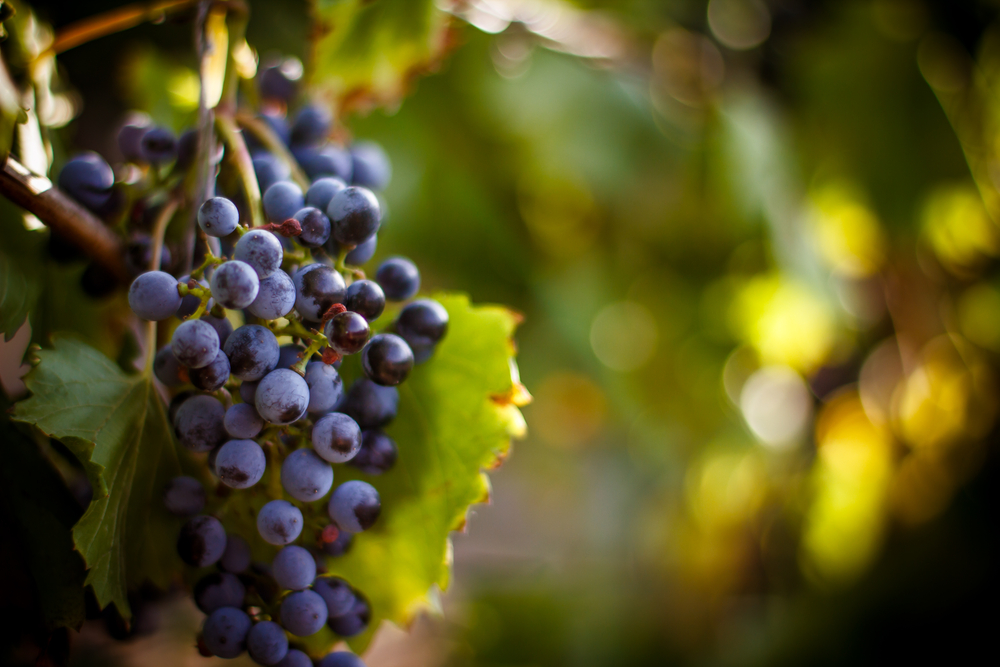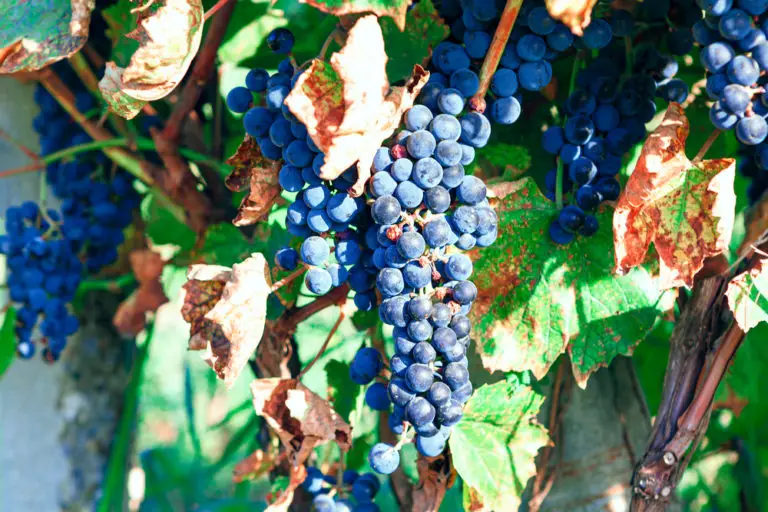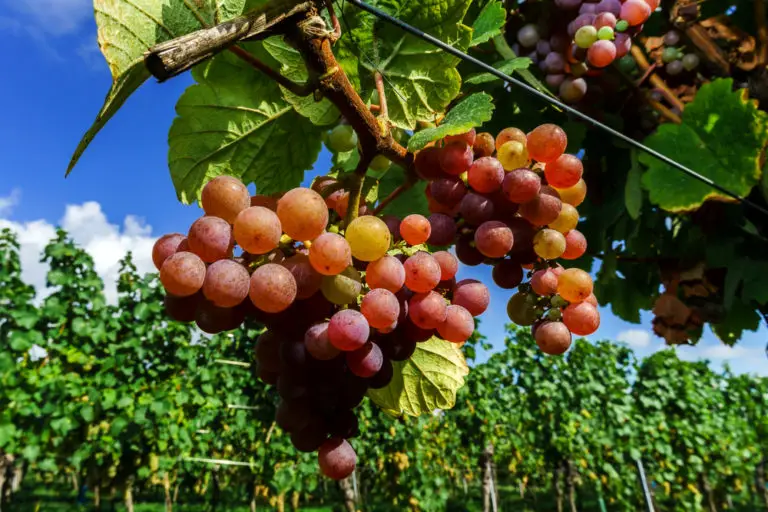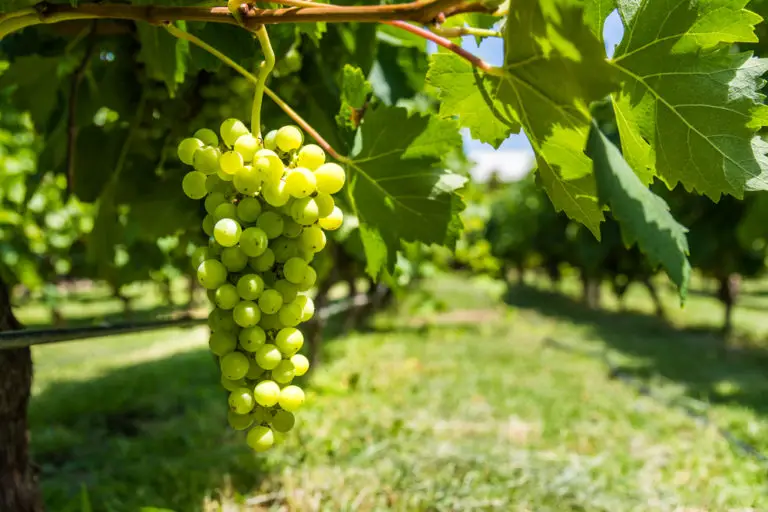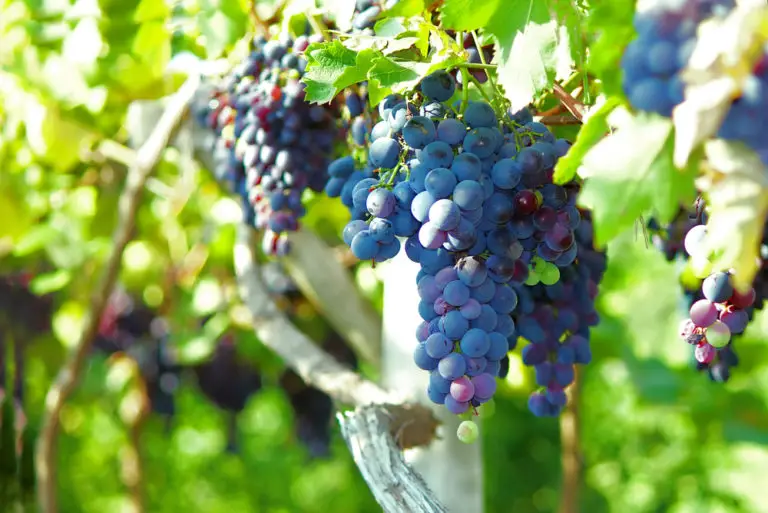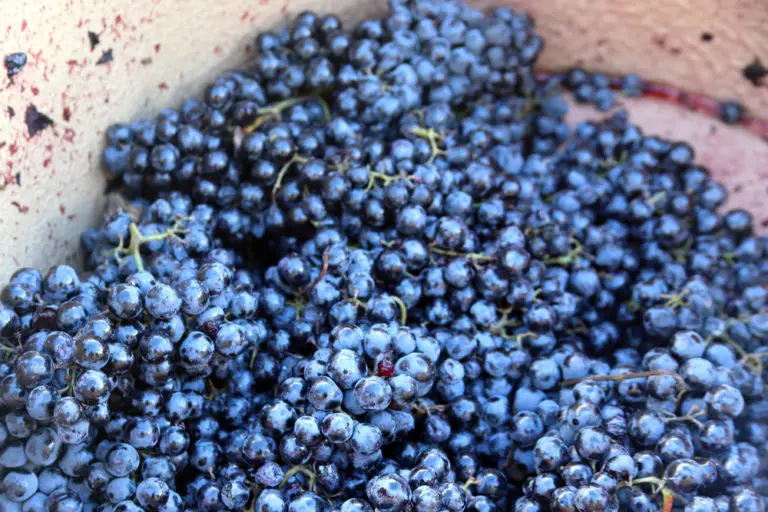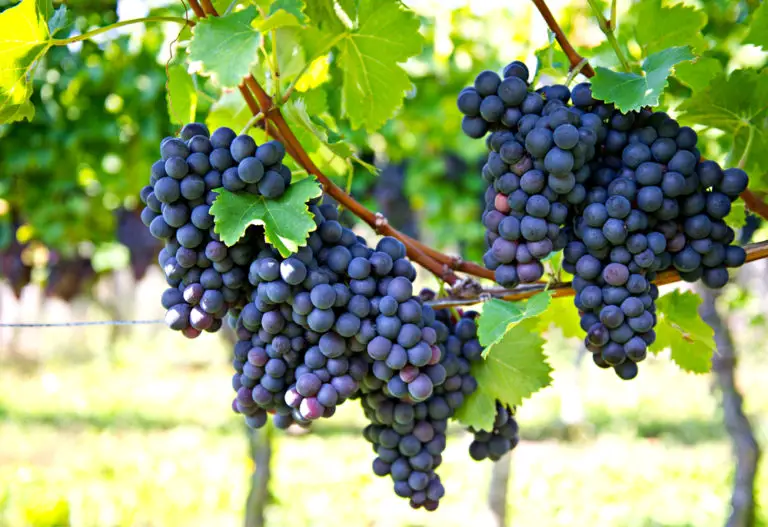Chambourcin: The Beginners Guide (2024)
Chambourcin is a red grape variety (also “Seyve 2605”), and a hybrid of an American vine and a European vine. It is, therefore, a French hybrid. The wine made is dark and aromatic but, unlike other hybrids, has no Fox tone. According to European Union regulations, the grape variety is not (yet) officially approved.
- What is Chambourcin?
- Known Regions for Chambourcin
- Popular Blends of Chambourcin
- How to Enjoy Chambourcin?
- How is Chambourcin Made?
- History of Chambourcin
- Alternatives for Chambourcin
What is Chambourcin?
The Chambourcin is a relatively young new breed, the exact year of origin is unknown. What is certain is that the Chambourcin itself was involved as a cross-partner in the two new breeds, Regent and St. Vincent. The Chambourcin is named after the commune of Bougé-Chambalud in the French department of Isère.
The late-ripening red grape variety is vigorous and delivers high yields. It shows high resistance against downy mildew, somewhat less against powdery mildew and black rot. However, it does not cope well with drought. It works particularly well in a warm, humid environment.
Dark red, aromatic red wines (without Foxton!) can be made from the Chambourcin. Chambourcin flavor profiles are mostly black cherry, plum, spices, and herbs. Outside France, the Chambourcin has enjoyed great popularity, especially in Canada and various states of the USA and Australia.
Chambourcin vs. Cabernet Franc vs. Merlot
A Cabernet Sauvignon is characterized by the smell of cassis and cedarwood and the taste of dark berries, licorice, spices, and green peppers. It has a deep dark red color and is very tannic. This wine goes well with many types of wine, which is why it is a good partner in a cuvée. Both Cabernet Franc and Chambourcin are red wines, are hybrids, and are originally from France.
The Merlot has an intense, garnet-red color, and if it has been matured in barriques (oak barrel with 225 liters), it can also be ruby red. In both cases, the Merlot sparkles in the glass when a brighter light source falls on it. Its bouquet is powerful, and its taste is extremely pleasant. The velvety-soft character of the Merlot wine makes it perfect for a cuvée.
It ensures a harmonious taste of the red wine, for which it is so valued. Its dark red color promises a great aroma of plums and cherries. Merlot is again a French red wine similar to Chambourcin.
Chambourcin Characteristics
Chambourcin pronunciation SHAM-bore-sin is a late-ripening variety (like Merlot) with strong growth and high yield. It is, therefore, more suitable for southern locations. It requires a strong base. A Chambourcin grape is large and more or less compact but often has insufficiently fertilized small berries. Yield should be regulated for the benefit of quality. Chambourcin alcohol content is 13% to 14%.
Chambourcin wine color is deep and it is an aromatic wine. It can be made dry or with moderate residual sugar content. The juice of this wine is more pink or red than clear, like most red Vitis vinifera varieties. The red juice fermented over the redskins can make a very strongly flavored wine.
Most red wines are served at room temperature to enhance the taste. However, some Chambourcin wines have such a strong taste that they are recommended to be served chilled. The wine is full-bodied, has a Mediterranean character, and is somewhat reminiscent of Merlot. As a young wine, it can still appear rough.
Chambourcin Taste Profile
Chambourcin profile is defined as an aromatic and deep-colored red wine made from teinturier grapes. It means that the juice is red or pink, unlike most other red wines, which have a clear color. Some winemakers use oak in the winemaking process to make it less acidic, which is typically high in colder regions. Chambourcin alcohol percentage typically lies between 13 to 14.
Chambourcin has modest tannins, strong flavors and is highly acidic that can be enhanced by aging it in oak. The Chambourcin taste is mostly having fruity notes of red fruit, black cherry, black pepper, herbaceous notes, and chocolate. It can be used as a single variety or as a blend. It is often blended with Shiraz in Australia.
It is sometimes even made into a bottle of sparkling red wine or semi-sweet wine. It is best consumed young as it has a typical freshness and can be drunk chilled because of its typically strong Chambourcin flavor.
Chambourcin Ageability
A typical Chambourcin red wine is allowed to be fermented in small 1 ton bins. When the fermentation process is completed, the grapes are allowed to stay there for another 2-3 weeks. This technique is called extended maceration. Further, they extract the phenolic compounds from the grape giving the wine more palate length and structure.
The Chambourcin grapes are pressed and then moved into a barrel for 24 months. The barrels used are normally new American oak barrels as they add more tannins to the wine.
Known Regions for Chambourcin
Chambourcin is a red grape variety grown in many regions of the World. Since it is considered a very productive grape, it is grown in humid regions. Let us have a look at some common Chambourcin regions.
- Australia: It is widely grown in the humid regions of coastal NSW, like Queensland and the Hunter Valley. The pioneer of this variety in Australis is John Cassegrain in the Hastings River Wine Region. You can find a ‘foxy’ flavor common to American Vitis varieties and hybrids can be detected in some.
- North America: This variety of grapes is widely grown in the mid-Atlantic region of North America. It is commonly grown in the states of Pennsylvania, New York, and New Jersey.
- Canada: Several vineries of this Chambourcin variety of grapes are also located in Harrow and Ruthven, Ontario, and in Kelowna, B.C.
- The United States of America: Some other counties where Chambourcin is widely grown are Washington, Virginia, Kentucky, Kent County, Delaware Roane, and Mineral counties in West Virginia, Western Tennessee in the Mississippi Delta AVA, St. Mary’s County, Maryland, the Hunter Valley Region of New South Wales, the Yadkin Valley and Haw River Valley of North Carolina, and the Shawnee Hills AVA of southern Illinois.
Popular Blends of Chambourcin
You can find a lot of wines that are 100% pure Chambourcin abv and others that are blended with some other varieties. It is commonly blended with Pinot Noir, but you can also find other blends from Chambourcin blends like:
- Pinnacle Ridge Quaff: This semi-sweet wine is a blend of Syrah, Pinot Noir, and Chambourcin. It has only 2% residual sugar and makes an excellent pair for pizza, therefore also known as “Pizza Wine.”
- Fletched: This is a sweet blend of three varieties- blackberry, Chambourcin, and Vidal Blanc. It is just like blending three fruits to create a sweet wine, having a note of black raspberry and fresh cherries.
- Butler Red Select: This light red fruity wine is a blend of Chambourcin with two less known grape varietals, namely, Marechal Foch and Marquette. It makes an excellent pair with pork and pasta dishes. Butler is one of the famous Chambourcin wine brands.
- Winter Blend: This Chambourcin and apple wine blend is sweet. It gives an apple and ripe cherry taste when warmed.
- Butler Variant: This is a blend of Marquette and Chambourcin that is made in the old-world style. This wine is aged in French oak and has cherry notes and herbal aromas.
- Yellowwood Red: This blend from New York is made of Marechal Foch, Marquette, and Chambourcin. It is the favorite wine of many people and pairs well with barbeque, pizza, and spaghetti.
How to Enjoy Chambourcin?
You will enjoy a glass of Chambourcin at its best when you drink it at the ideal serving temperature, in the right stemware that brings its flavors and aromas out and the correct food. Though there are some universal rules that you can follow while drinking any red wine, sometimes rules may differ. Here are some Chambourcin pairing suggestions.
Food Pairings
Chambourcin’s name is a very food-friendly wine. You can just look around in your kitchen and easily find something that you can have with it. Chocolate cake, strawberry, apple sauce, brie, short ribs, sausage, pasta+red sauce, walnuts, mushrooms, you can have any of these with Chambourcin or make a dish out of these ingredients. Let us see some common Chambourcin wine pairing:
- Enchiladas: This dish is very delicious, and even vegans can eat it. The recipe may not be the easiest or quickest but goes perfectly with the Chambourcin wine. The depth of the flavor from chocolate and mushroom with the richness of wine works amazingly.
- Australian Sausage Sizzle: This is an easy and fun pairing that is widely popular in Australia. The recipe is simple, and you can serve it with slightly chilled Chambourcin to enjoy the simplicity of this combination.
Temperature
Serving red wines at room temperature is an old rule of thumb. But it is old and dates back to times when the apartments were rather cool, even in summer. Powerful heavy wines taste best at 18, at most 19°C, while temperatures between 16 and 18°C are suitable for most other red wines. Lighter wines also tolerate lower temperatures between 14 and 16°C.
Ideally, you should be drinking Chambourcin at room temperature. You can also enjoy it chilled like a white wine on a hot summer day.
Stemware
Red wines are to be typically served in a wine glass having a bigger bowl and longer stem. A bigger bowl allows you to take the aromas before sipping and enjoy it to the fullest. A longer stem makes sure that your body temperature does not impact the flavors of the wine. Some stemwares which are perfect to drink Chambourcin are:
- Villeroy & Boch “Vivo” red wine glasses: The Vivo series by manufacturer Villeroy & Boch is aimed at the normal wine drinker who needs a good wine glass for everyday life. The wine glasses are relatively robust but still have some brilliance. The design of the Vivo wine glasses is stylish and traditional.
- Leonardo Puccini red wine glass: The Leonardo wine glasses Puccini are stable and inexpensive. You can hardly avoid them. The quality of the wine glasses is robust, relatively thick-walled, and therefore not nearly as filigree and elegant as is the case with higher quality glasses.
- Spiegelau Nachtmann red wine glass: With its tulip shape, the goblet shape of the wine glasses represents a classic red wine glass, but in our opinion, it is not particularly innovative or modern. The glass quality of the Style wine glasses is robust and is reinforced by the use of the so-called platinum process, which makes the glasses even more durable for Chambourcin alcohol.
- Schott Zwiesel red wine glasses: These wine glasses, too, are rather simple in terms of their design and execution but quite functional. The shape of the goblet is designed, in such a way, that a relatively large number of different wines can be enjoyed in it. The processing of the glasses is robust and relatively thick-walled and therefore suitable for everyday use.
How is Chambourcin Made?
Like any other wine, Chambourcin goes through various stages to be converted into wine. The process depends a lot on different winemakers, but the following are the common steps involved in Chambourcin winemaking.
1. Harvesting
First of all, the grapes must be harvested from the Chambourcin vineyard as ripe as possible. Whether this is done by machine or hand depends on many factors and cannot generally be described as good or bad. It is vital to bring the grapes (berries with style) quickly and safely for further processing. The berries like to burst and react very quickly to contact oxygen and other chemical substances.
2. Destemming
In the next step, the grapes are destemmed, depending on the winemaker’s wishes. In most cases, less destemmer is used in red wine production than in white wine production.
3. Mashing
Mashing refers to the crushing of the berries that takes place in the next step. The juice, the skin of the berries, seeds, and possibly the style are “on the mash” for a short time. The first aromas and colorings dissolve, and at a certain temperature, mash fermentation begins.
4. Fermentation
Red wines tend to be fermented on the mash. It creates alcohol and carbonic acid. Fermentation can take place spontaneously, with your natural yeasts or with the addition of so-called “pure yeasts”. The resulting carbonic acid drives the mixture of shell, style, and core to the surface of the container again and again.
5. Press
To separate the wine from the solid components, the flow, the part of the liquid that runs off without pressure, is removed. The remainder is pressed, and the so-called pressed wine that is produced is often kept separate because it contains a high level of tannin. The pressed wine can later be blended with the pre-run wine if it is to have a stronger tannin structure.
6. Clarification
When the fermentation is complete, the Chambourcin meaning the wine is separated from the dead yeast utilizing clarification/filtration and free from turbidity and proteins.
History of Chambourcin
The Chambourcin is a relatively young new breed, the exact year of origin is unknown. It is a new breed between Seyve Villard 12-417 x Chancellor, which has been marketed since 1963.
The exact parentage of the red grape variety is unknown, however, as the crossing documents of their breeder Johannes Seyve can no longer be found. The Chambourcin history tells that it is named after the commune of Bougé-Chambalud in the French department of Isère.
In their home country France, this new breed is only cultivated to a limited extent. Originally it was only used to press country and table wines in the meantime, its cultivation was even prohibited, but since 2008 it has been approved again and covers an area of around 800 hectares. It can be found mainly on the Rhône.
Alternatives for Chambourcin
If you have tried Chambourcin, loved the taste, and want to try some alternatives to this red wine, then you can try these popular alternatives- Chardonnay, Merlot, or Pinot Noir. All three wines can be easily found in your nearby stores, and you can enjoy them at any time that you want.
Chardonnay
Chardonnay is often used as a single variety having fresh aromas of citrus, apple, and melon. The typical taste of this variety is a little smoky with a hint of walnut. It has a relatively high alcohol content of at least 13%. Depending on the growing area, you will find fresh, light to exotic, aromatic Chardonnay wines that always promise enjoyment.
Merlot
Merlot wine is dark red, has a medium alcohol content, and tastes soft and smooth, sometimes a bit like plums. It loves chalk-rich locations and delivers wines with silky tannins and lots of fruit. Merlot smells of cherries, plums, and sometimes of black currants, also of ivy and dark earth.
Pinot Noir
Pinot Noir is one of the finest red wine varieties in the world. Their rich bouquet is characteristic, which is usually associated with fresh strawberries, wild berries, cherries, or plums. Even spices and herbs, as well as mushrooms or leather in ripe wines, sometimes fill the nose with wine connoisseurs. The taste is in no way inferior to the fragrance of top wines: aromatic, fruity, and full-bodied.
FAQ
Is Chambourcin a sweet wine?
Chambourcin is a fully aromatic, deep-colored wine which can be both dry or sweet. Chambourcin wine taste does not have any unpleasant hybrid flavors.
How do you drink Chambourcin?
According to Charbourcin descriptors, the wine should be served at room temperature. You can also enjoy it chilled like a white wine on a hot summer day.
Is Chambourcin a white wine?
Chambourcin color is deep red. The grape itself is a “teinturier”, which means that its juice is pink or red instead of clear like most other red grapes.
Should Chambourcin be refrigerated?
Chambourcin characteristics are at their best when the wine is slightly chilled or is at room temperature. This will allow the complexity of wine to come through as they are swirled and sipped.
What is similar to Chambourcin?
You can replace the different types of Chambourcin with the wines like Chardonnay, Merlot, or Pinot Noir. It also tastes similar to Viognier, Chenin Blanc and Garganega.
Can you eat Chambourcin grapes?
Chambourcin is a medium-sized cluster of large, sweet, juicy grapes that are Seedless. They can also be consumed as table grapes.
Where is Chambourcin grown?
Chambourcin is commonly grown in the French Loire River Valley and Savoie in France. It is also grown in Australia, the USA, Canada, and North America.
What is Chambourcin a hybrid of?
Chambourcin is a French-American interspecific hybrid grape variety produced by Joannes Seyve who often used Seibel hybrids produced in the 1860s.

